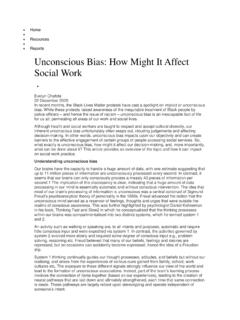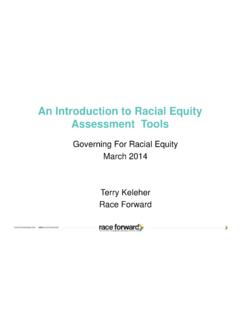Transcription of © 2021 Microsoft. All rights reserved.
1 2021 Microsoft. All rights reserved. Microsoft: Global Diversity & Inclusion unconscious bias : Understanding unconscious bias For those who would like additional accessibility support or a translation of the content, we recommend using the transcript with these Microsoft tools: Immersive Reader and Microsoft Translator. 2021 Microsoft. All rights reserved. Microsoft: Global Diversity & Inclusion unconscious bias : Understanding unconscious bias Slide Title Transcript Introduction Welcome to the unconscious bias training. This is a four-part course. This first module should take about 15 minutes to complete. Accessibility instructions Please take a moment to understand how to navigate this module before you get started. Use the Tab key to navigate to the Back and Next buttons. Use the Spacebar or Enter key to select and move to the next slide or review the previous side.
2 Use the Tab key to enter the sidebar and toggle between the Menu, Transcript, and Resources tabs. Use the Up and Down arrow keys to navigate the topics in the Menu. Select the Spacebar or Enter key to load a slide. Navigating this module Use the instructions on this page to navigate smoothly through this module. The sidebar toggle contains the Menu with the sections in this module, the Transcript, and the Resources. Select the Menu tab to review the sections covered in this module. Use the Transcript tab to review the transcript of the audio. Select the Resources tab to download the learning guide and other resources in this module. Adjust the volume using the Audio button. Select the CC button to toggle the video captions. Play or pause the slide using the Play/Pause button. Replay slides or videos with the Replay button.
3 Use the Back and Next buttons to move to the next slide or review the previous slide; and Select the Exit button to exit the module at any time and return to resume from the slide where you left off. Review all slides in the order they are presented to complete the module. Slides with interactions must be played completely before moving to the next slide. Welcome Most people want to be fair and objective individuals. But to be biased is to be human. And while biases are part of how we process the world, we need to take proactive steps to work through them. This course is an invitation to challenge ourselves and explore our own biases. Throughout the four modules, there will be opportunities to reflect and actively work on disrupting our biases. It may feel uncomfortable. That is okay, because it is part of the journey.
4 2021 Microsoft. All rights reserved. Microsoft: Global Diversity & Inclusion unconscious bias : Understanding unconscious bias Course roadmap We invite you to complete all four modules in this course. We encourage you to download the learning guide from the Resources tab, so you can make notes and capture your thoughts as you work through the content. The modules are: Module 1: Understanding unconscious bias Module 2: unconscious bias and Team Effectiveness Module 3: unconscious bias and Decision Making Module 4: Counteracting unconscious bias Module splash Let's begin our journey with the first module, Understanding unconscious bias .. Module introduction When we meet someone for the first time, we make assumptions about them based on the way they dress, look, or act. These reactions are indicators of unconscious bias , and they affect all of us every day.
5 In this module, we will deepen our understanding and learn about some common types of unconscious bias . Module objectives By the end of this module, you should be able to: Describe what unconscious bias is and how it impacts us in the workplace, and Identify some of the common types of unconscious bias in the workplace. Our assumptions Let's examine our own observations. What feelings or assumptions do you have about this person? Our assumptions Would you have guessed that he is a doctor, a father, and a mentor to the LGBTQI+ medical students at the university he attended? (continued). Let's check out another example. Another example What feelings or assumptions do you have about this person? Another example Would you have guessed that she is a business executive, a local council representative, and is leading education reforms in her (continued) community?
6 2021 Microsoft. All rights reserved. Microsoft: Global Diversity & Inclusion unconscious bias : Understanding unconscious bias Defining unconscious bias Our feelings and reactions to the people in the previous examples are the result of our unconscious bias . unconscious bias is defined as stereotypes, prejudices, or preferences that cause us to favor a person, thing, or group in a way that is deemed unfair. They are implicit attitudes, behaviors, words, or actions that we exhibit in our personal lives and in the workplace. We all have unconscious biases. They are mental shortcuts that help us navigate our day, effectively and efficiently. Let's now move on to some basic differences between conscious and unconscious biases. Comparing conscious and Conscious biases are explicit and often characterized by preferential treatment given to a person or specific groups of people.
7 unconscious bias unconscious biases are implicit or hidden. Both conscious and unconscious biases can cause us to behave negatively or discriminate against people. Scenario Let's find out how our biases can affect the workplace. Markus applied for parental leave to care for his newborn child. Although he was entitled to his leave, his project lead suggested that, as the father, he may choose not to take the full duration. Since his return to work, Markus has not been invited to team events, and he was overlooked for a new assignment. When he asked his project lead for an explanation, they told Markus that they did not want to introduce additional demands at work while he is adjusting to being a new parent. 2021 Microsoft. All rights reserved. Microsoft: Global Diversity & Inclusion unconscious bias : Understanding unconscious bias Knowledge check Let's check your understanding.
8 In what ways did Markus experience bias from his project lead and colleagues? Choose the best answer and select Submit. unconscious bias Conscious bias Both conscious bias and unconscious bias Neither conscious bias nor unconscious bias The best answer is both conscious bias and unconscious bias . When initially requesting parental leave, Markus's project lead demonstrated conscious bias by suggesting that a man may require less time with his family. Upon returning from leave, the project lead demonstrated unconscious bias that a new parent may not be capable of balancing work and family needs. In this scenario, the project lead's unconscious bias also impacted Markus's career progression and future opportunities. Making changes Conscious and unconscious biases can be detrimental to us and our society.
9 Once we understand and acknowledge that we all have bias , we have a duty to each other to work on how to mitigate its negative effects. 2021 Microsoft. All rights reserved. Microsoft: Global Diversity & Inclusion unconscious bias : Understanding unconscious bias Did you know? Our unconscious biases can affect our interactions both inside and outside the workplace. 42% of people around the world think that men make better business executives than women. This figure reflects the deep roots of gender inequality and invisible barriers that continue to operate in the workplace, which are often hidden or unconscious . Select the arrow buttons to navigate. An estimated 1 billion people worldwide are living with a disability. The unemployment rate for people with disabilities is TWO. TIMES that of people without disabilities.
10 Employers often assume that people with disabilities do not have the same skills and capabilities as those without a disability, which is a form of unconscious bias . A European study showed that 50% of the time, r sum s with older-sounding names are less likely to be considered for a job than identical r sum s with modern-sounding names. unconscious bias can lead to the assumption that adults with older-sounding names are less likely to have the skills required for today's jobs. Over 40% of employees from Asian, Black, Latinx, and multiracial backgrounds report being cautious in the workplace because they anticipate racial or ethnic bias . This causes an emotional tax that affects their overall health, well-being, and ability to thrive. These are only a few examples. Let's now find out how unconscious bias impacts inclusion in the workplace.

